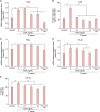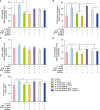Epidermal Growth Factor Attenuated the Expression of Inflammatory Cytokines in Human Epidermal Keratinocyte Exposed to Propionibacterium acnes
- PMID: 29386833
- PMCID: PMC5762477
- DOI: 10.5021/ad.2018.30.1.54
Epidermal Growth Factor Attenuated the Expression of Inflammatory Cytokines in Human Epidermal Keratinocyte Exposed to Propionibacterium acnes
Abstract
Background: While the beneficial effects of topical epidermal growth factor (EGF) on wound healing have been repeatedly reported, there are few reports about the effects of EGF on inflammatory skin diseases including acne.
Objective: To clarify the effects of EGF on acne, it was investigated whether recombinant human EGF (rhEGF) signalling can affect Propionibacterium acnes-induced cytokine expression in human epidermal keratinocytes.
Methods: The cultured normal human epidermal keratinocytes (NHK) were co-treated with P. acnes and rhEGF, and mRNA levels of interleukin (IL)-1α, IL-8 and tumor necrosis factor (TNF)-α; toll-like receptor 2 (TLR2); and nuclear factor kappa B (NF-κB) were determined. Specific enzyme-linked immunosorbent assay kits were used to measure the IL-1α, IL-8 and TLR2 expression as well as the NF-κB activation in P. acnes and rhEGF-treated NHK. After infecting the cultured NHK with live P. acnes, an increased expression of IL-1α, IL-8 and TNF-α was detected, which was prevented by rhEGF co-treatment.
Results: TLR2 and NF-κB activity increased after P. acnes treatment, and rhEGF treatment decreased TLR2 expression and NF-κB activity dose-dependently. The inhibition of EGF receptor by gefitinib attenuated the inhibitory effect of rhEGF on these increased expressions of proinflammatory cytokines and TLR2 and activity of NF-κB in NHK stimulated by P. acnes.
Conclusion: These results suggest that EGF attenuated P. acnes-induced inflammatory responses, at least in part, through the modulation of TLR2 signalling, and the topical application of rhEGF may be beneficial to relieve the inflammatory reactions of acne.
Keywords: Acne vulgaris; Epidermal growth factor; Propionibacterium acnes; Toll-like receptor 2.
Conflict of interest statement
CONFLICTS OF INTEREST: The authors have nothing to disclose.
Figures





References
-
- McInturff JE, Modlin RL, Kim J. The role of toll-like receptors in the pathogenesis and treatment of dermatological disease. J Invest Dermatol. 2005;125:1–8. - PubMed
-
- Akira S, Uematsu S, Takeuchi O. Pathogen recognition and innate immunity. Cell. 2006;124:783–801. - PubMed
-
- Shibata M, Katsuyama M, Onodera T, Ehama R, Hosoi J, Tagami H. Glucocorticoids enhance Toll-like receptor 2 expression in human keratinocytes stimulated with Propionibacterium acnes or proinflammatory cytokines. J Invest Dermatol. 2009;129:375–382. - PubMed
-
- Li ZJ, Choi DK, Sohn KC, Seo MS, Lee HE, Lee Y, et al. Propionibacterium acnes activates the NLRP3 inflammasome in human sebocytes. J Invest Dermatol. 2014;134:2747–2756. - PubMed
LinkOut - more resources
Full Text Sources
Other Literature Sources

